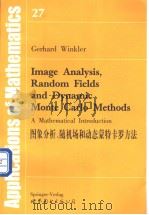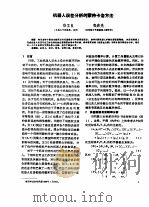《图像分析、随机场和动态蒙特卡罗方法》
| 作者 | Gerhard Winkler著 编者 |
|---|---|
| 出版 | 世界图书出版公司北京公司 |
| 参考页数 | 324 |
| 出版时间 | 1999(求助前请核对) 目录预览 |
| ISBN号 | 750623825X — 求助条款 |
| PDF编号 | 81056738(仅供预览,未存储实际文件) |
| 求助格式 | 扫描PDF(若分多册发行,每次仅能受理1册) |

Introduction1
Part Ⅰ.Bayesian Image Analysis:Introduction13
1.The Bayesian Paradigm13
1.1 The Space of Images13
1.2 The Space of Observations15
1.3 Prior and Posterior Distribution16
1.4 Bayesian Decision Rules19
2.Cleaning Dirty Pictures23
2.1 Distortion of Images23
2.1.1 Physical Digital Imaging Systems23
2.1.2 Posterior Distributions26
2.2Smoothing29
2.3 Piecewise Smoothing35
2.4 Boundary Extraction43
3.Random Fields47
3.1 Markov Random Fields47
3 2 Gibbs Fields and Potentials51
3.3 More on Potentials57
Part Ⅱ.The Gibbs Sampler and Simulated Annealing65
4.Markov Chains:Limit Theorems65
4.1 Preliminaries65
4.2 The Contraction Coefficient69
4.3 Homogeneous Markov Chains73
4.4 Inhomogeneous Markov Chains76
5.Sampling and Annealing81
5.1Sampling81
5.2 Simulated Annealing88
5.3 Discussion94
6.Cooling Schedules99
6.1 The ICM Algorithm99
6.2 Exact MAPE Versus Fast Cooling102
6.3 Finite Time Annealing111
7.Sampling and Annealing Revisited113
7.1 A Law of Large Numbers for Inhomogeneous Markov Chains113
7.1.1 The Law of Large Numbers113
7.1.2 A Counterexample118
7.2 A General Theorem121
7.3 Sampling and Annealing under Constraints125
7.3.1Simulated Annealing126
7.3.2 Simulated Annealing under Constraints127
7.3.3 Sampling with and without Constraints129
Part Ⅲ.More on Sampling and Annealing133
8.Metropolis Algorithms133
8.1 The Metropolis Sampler133
8.2 Convergence Theorems134
8.3 Best Constants139
8.4 About Visiting Schemes141
8.4.1Systematic Sweep Strategies141
8.4.2 The Influence of Proposal Matrices143
8.5 The Metropolis Algorithm in Combinatorial Optimization148
8.6Generalizations and Modifications151
8.6.1 Metropolis-Hastings Algorithms151
8.6.2 Threshold Random Search153
9.Alternative Approaches155
9.1 Second Largest Eigenvalues155
9.1.1 Convergence Reproved155
9.1.2 Sampling and Second Largest Eigenvalues159
9.1.3 Continuous Time and Space163
10.Parallel Algorithms167
10.1 Partially Parallel Algorithms168
10.1.1 Synchroneous Updating on Independent Sets168
10.1.2 The Swendson-Wang Algorithm171
10.2 Synchroneous Algorithms173
10.2.1 Introduction173
10.2.2 Invariant Distributions and Convergence174
10.2.3 Support of the Limit Distribution178
10.3 Synchroneous Algorithms and Reversibility182
10.3.1 Preliminaries183
10.3.2 Invariance and Reversibility185
10.3.3 Final Remarks189
Part Ⅳ.Texture Analysis195
11.Partitioning195
11.1 Introduction195
11.2 How to Tell Textures Apart195
11.3 Features196
11.4 Bayesian Texture Segmentation198
11.4.1 The Features198
11.4.2 The Kolmogorov-Smirnov Distance199
11.4.3 A Partition Model199
11.4.4 Optimization201
11.4.5 A Boundary Model203
11.5 Julesz's Conjecture205
11.5.1 Introduction205
11.5.2 Point Processes205
12.Texture Models and Classification209
12.1 Introduction209
12.2 Texture Models210
12.2.1 The φ-Model210
12.2.2 The Autobinomial Model211
12.2.3 Automodels213
12.3 Texture Synthesis214
12.4 Texture Classification216
12.4.1 General Remarks216
12.4.2 Contextual Classification218
12.4.3 MPM Methods219
Part Ⅴ.Parameter Estimation225
13.Maximum Likelihood Estimators225
13.1 Introduction225
13.2 The Likelihood Function225
13.3 Objective Functions230
13.4 Asymptotic Consistency233
14.Spacial ML Estimation237
14.1 Introduction237
14.2 Increasing Observation Windows237
14.3 The Pseudolikelihood Method239
14.4 The Maximum Likelihood Method246
14.5 Computation of ML Estimators247
14.6 Partially Observed Data253
Part Ⅵ.Supplement257
15.A Glance at Neural Networks257
15.1 Introduction257
15.2 Boltzmann Machines257
15.3 A Learning Rule262
16.Mixed Applications269
16.1 Motion269
16.2 Tomographic Image Reconstruction274
16.3 Biological Shape276
Part Ⅶ.Appendix283
A.Simulation of Random Variables283
A.1 Pseudo-random Numbers283
A.2 Discrete Random Variables286
A.3 Local Gibbs Samplers289
A.4 Further Distributions290
A.4.1 Binomial Variables290
A.4.2 Poisson Variables292
A.4.3 Gaussian Variables293
A.4.4 The Rejection Method296
A.4.5 The Polar Method297
B.The Perron-Frobenius Theorem299
C.Concave Functions301
D.A Global Convergence Theorem for Descent Algorithms305
References307
Index321
1999《图像分析、随机场和动态蒙特卡罗方法》由于是年代较久的资料都绝版了,几乎不可能购买到实物。如果大家为了学习确实需要,可向博主求助其电子版PDF文件(由Gerhard Winkler著 1999 世界图书出版公司北京公司 出版的版本) 。对合法合规的求助,我会当即受理并将下载地址发送给你。
高度相关资料
-

- 蒙特卡罗方法引论
- 1987 济南:山东大学出版社
-

- 卡斯特罗和古巴 下
- 1975 上海:上海人民出版社
-

- 图象分析、随机场和动态蒙特卡罗方法
- 1999 世界图书出版公司北京公司
-

- 汽轮机调节动态特性 计算、分析、试验和研究方法
- 1991 北京:水利电力出版社
-

- 蒙特卡罗方法
- 1985 上海:上海科学技术出版社
-

- 动态信号分析和仪器
- 1990 北京:机械工业出版社
-

- 卡斯特罗和古巴 上
- 1975 上海:上海人民出版社
-

- 蒙特卡罗方法在农业气象学中的应用
- 1989 北京:气象出版社
-

- 随机数据分析方法
- 1976 北京:国防工业出版社
-

- 管理学 管理职能的系统分析方法和随机制宜的分析方法
- 1982 贵阳:贵州人民出版社
-

- 动态图像分析
- 1999 北京:国防工业出版社
-

- 随机振动分析
- 1977 北京:地震出版社
提示:百度云已更名为百度网盘(百度盘),天翼云盘、微盘下载地址……暂未提供。➥ PDF文字可复制化或转WORD


